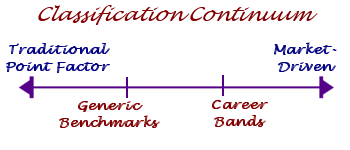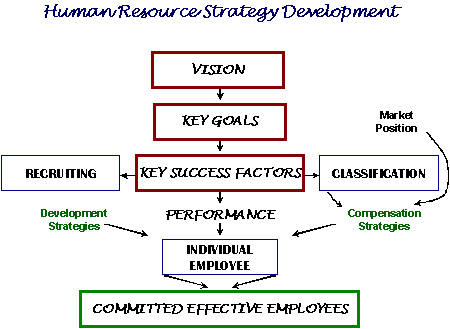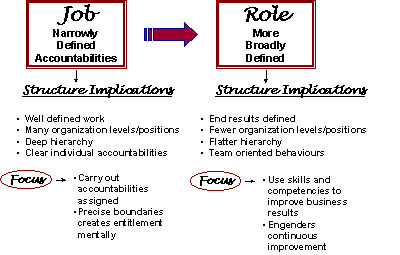|
Current Trends in
Classification Approaches
Organizations are considering a number of
classification approaches that include:
-
Competency-based job classification that is
often accompanied by broad banding that enables organizations to reward the
acquisition and demonstration of the competencies required for job and/or
organization success.
-
More flexible, person-based pay systems which
allow for salary range penetration that is linked to the value the
organization derives from a specific grouping of skills that an individual
brings to the organization.
-
Generic job classification matrices that
provide organizations with the ability to quickly assess the value of
positions that are undergoing considerable evolution.
Job classification
system features that emerging include:
-
Focus on fewer customized factors that are
linked to their strategy. E.g. wowing the customer, thinking outside the box
and reflect the core competencies required for future success.
-
Requisite organization models that are fairly
generic and describe the nature of the work that is typically done at each
level in the organization.
One of the key learnings from the literature
review is that the type of classification system that an organization should
reflect the structure of the organization and the current business environment.
For example, a highly structured, multi-layered organization that needs to
preserve its current structure, should choose a very different model than a
company that has a flat structure and positions and/or roles that are in a
constant state of change.
General Trends from Best
Practices Interviews
Demographics
The sample consisted of 38 organizations from
across Canada in the following industry sectors:

The size of organizations, by number of
employees:

Classification Approach
-
The majority of respondents reported a fairly
high level of satisfaction (averaging 7 out of 10) with their current
classification system.
-
Organizations primarily use job classification
for classifying or placing jobs into pay bands, or maintaining internal
equity.
-
Other uses identified by organizations
include:
-
71% reported their classification system is
linked to their business strategy through identifying and using factors that
reflect the business strategies and the key competencies needed to achieve
them.
-
The most common approaches of Classification
Systems include:
-
Traditional Point Factor or Factor
Comparison
-
Generic Benchmarks by Job Family (often
based upon point factor methodology)
-
Career Banding based on competencies
descriptions
-
Market-Driven
-
The evolving trend is towards more use of
generic and broad band classification strategies, at least for
administration. Many of the generic systems are derivatives of a point
factor or factor comparison approach.
-
Classification systems typically had one or
more of the following :
|
Feature
|
Percentage
|
|
Benchmark Positions
|
86%
|
|
Position Questionnaires
|
57%
|
|
Use of Job Families
|
59%
|
|
Use of Committees
|
50%
|
-
This supports the growing trend towards
generic systems and away from detailed evaluation requiring on-going
classification committees.
-
60% of organizations use more than one
classification system, generally having separate systems for executive
positions and often unionized positions. Consistency between the systems is
typically a Human Resources and/or Management Role.
-
The vast majority of organizations described
some level of involvement and role for all groups (Executive, Senior
Management, Team Leaders, Employees, Union, and Human Resources).
Factors Affecting the
Success of the Classification System
-
The single most important factor identified as
critical to a successful job classification system is clear alignment of
the classification system with the organizationís strategic directions.
-
The other 3 key organizational factors which
contributed to the successful introduction and administration of the
classification system were:
-
Executive and Management support and
involvement.
Commitment at all levels of management, so that they
own the system and their actions support it.
-
Involvement by employees.
Input and
feedback through the design, implementation, and ongoing use phases
allows employees to share in ownership of the system, while limiting the
direct control over the system design.
-
Communication. Open communication
of system and values allows all levels of employees to understand how
the system works and what the expected results are and what that means
to them in their own terms.
Lessons Learned
Some organizations identified some "lessons
learned" that are useful to consider:
-
what the process is,
-
who is involved and what their role is,
-
what outcomes are expected, and
-
when specific phases will be completed
-
The larger the movement in classification
philosophy, e.g. from traditional point factor to career bands, the more
time and effort that is necessary in communicating and educating employees
at all levels.
-
In a benchmark or career band system, the
clustering of similar positions in the initial stages, can save a
significant amount of time. This can also reduce the number of different
positions that must be classified and provides a valuable focus for employee
and team leader involvement.
-
Allocate sufficient time and resources for
educating and training employees at all levels about the new system and how
it works. Be prepared for a lengthy learning curve.
Best Practices
Observations
"The single most important factor
identified as critical to a successful job classification system is clear
alignment of the classification system with the organizationís strategic
directions."
The development of integrated human resource
strategies aligned with organizational direction reinforce the same
principles and values that make it easier for employees to understand Human
Resourcesí processes and their relevance to organizational success. Please
see Table 1 below.
Successful classification system typically has
clear links to many other Human Resourcesí processes as demonstrated in
Table 2 below.
There is strong evidence to suggest that
positions are no longer being viewed as narrowly defined jobs with very
specific duties and processes. Instead there is a migration to the view of
positions as roles that focus on accomplishing results.
The goals of many emerging classification
systems are focused on:
A streamlined process, that is fast and easy
to administer.
Placing the prime responsibility for
classification, compensation and performance decisions with the management
of operating units.
Human Resourcesí role as a technical
resources to managers and monitoring results for internal equity.
Open systems that all levels within the
organization have access to including factors or benchmarks and specific
position descriptions.
These goals support the migration path that many
organizations are taking from the traditional point factor systems towards
career bands. These are typically supported by competencies and often tied to
market-based compensation.
The classification approaches identified in this
study could be placed along a continuum, with traditional point factor at one
end and market-driven strategies at the other. The 2 other distinct strategies
identified were generic benchmarks and career bands, although many of the
systems observed were variations and combinations that fell between these 2
strategies.


Table 1
CHANGING
EXPECTATIONS/EVOLUTION OF WORK

Table 2
CLASSIFICATION
SYSTEM CONTINUUM
|
Components
|
Traditional
Point
Factor
|
Generic
Benchmarks
|
Career
Bands/
Competencies
|
Market
Driven
|
|
Internal
References
|
Benchmarks
|
Benchmarks
|
Benchmarks
|
Market Benchmarks
only
|
|
Data
Collection
|
Detailed Job
Description Or Questionnaires
|
High Level Factor
And Job Family Descriptions
|
Competency
Descriptions For Each Level Of Expertise
|
Market Data
Collected
|
|
Roles
|
HR Key Role
|
Jobs Slotted By:
Line, Line and HR,
Or HR alone
HR Review Optional
|
Jobs Slotted By
Line
HR May Review Recommendations Of Line
|
Line Management/
HR
|
|
Committee Role
|
Line Committees
-
Evaluate benchmarks
-
Approve Evaluations
|
Line Committee
during design phase
Optional for on-going
|
Line committee
may be involved during design phase.
|
Not Required
|
|
Links to other
HR Practices
|
Maybe loosely
linked to recruiting
Salary ranges are based upon point bands
|
Strong links to
employee development within job families
Compensation is salary ranges or broad
bands
|
Strong links to
performance management, employee development
Compensation often market-based broad
bands
|
Few strong links
Performance management typically the
strongest
Compensation based on market-based rates/
bands
|
|
Pros
|
Internal Equity
Maintained
Defensible re: Pay Equity
Can determine small differences between
jobs
|
Can align with
org focus
Managerial flexibility
Reflects Job Family characteristics
May be transition towards
Competency-based system
More focus on roles
Easy to understand & administer &
is flexible
Defensible re: Pay Equity
|
Focus On roles
& results
Managerial flexibility
Directly aligned to org focus through
competencies
Defensible re: Pay Equity
|
Supports full
managerial control and discretion of classification placement.
Very simple and responsive to change
|
|
Cons
|
Time Consuming
-
Detailed descriptions for each job
-
May be difficult to align with org
focus
-
May require frequent reclassifications
|
Minor job
differences may not be captured
|
Time-consuming to
develop and implement Communication and education must be extensive
Low Internal Equity Focus
|
No Internal
Equity focus
Defensibility re: Pay Equity is a greater
challenge
|
For more information on innovative
Classification Systems:
THE WYNFORD GROUP
management consultants
THE WYNFORD GROUP, is a compensation
consulting firm specializing in:
Our goal is to facilitate organizational
effectiveness by developing innovative solutions to specifically fit
client needs and provide continuing value.
We are well-known for conducting customized and broad-based
surveys for many purposes including organizational assessments to compensation
market comparisons.
We conduct the Information & Advanced
Technology Compensation Survey
The IT Compensation Standard
in Western Canada
THE WYNFORD GROUP performance programs
include: Contribution Process Performance ScoreCards and Competency-Based
Strategies.
We have worked extensively with innovative and
entrepreneurial organizations in all sectors but particularly in the information
technology, hi-tech and energy sectors.
|






